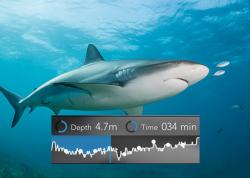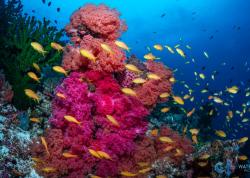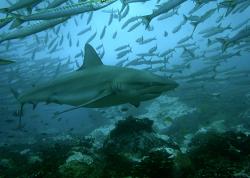Silky Sharks of Malpelo Island
Located in the tropical region of Eastern Pacific, three hundred miles due West of the Colombian coast, the Island of Malpelo sits well off the beaten path. Only recently has it evolved from a “what's that” curiosity into a bucket-list dive destination offering unique opportunities for big-fish encounters (see our Malpelo Dive Guide). “The Rock” is a marvel of nature in itself. Inhospitable and awe-inspiring, the vertical cliffs of the island are at the same time mysteriously relaxing. For the rapidly growing number of Malpelo fans, the Rock is not just a favorite place where they go to dive – it is more like a Cathedral where you go to worship.
The sense of solitude here is absolute. Only one dive boat, with no more than 16 divers on board, is allowed in Malpelo waters at any one time. This means that the divemaster is free to choose the best dive site for the current conditions without worrying about a crowd. This isn’t always the case with other ocean island in the eastern Pacific. The most convenient liveaboard for Malpelo is Panama-based MV Yemaya.
Book Your Trip to Malpelo Island
Bluewater Travel can help you plan and book the perfect Malpelo Island dive trip.
Email bookings@bluewaterdivetravel.com for more info.
Liveaboard MV Yemaya in Malpelo waters.
The Fish
Malpelo is most commonly known for astonishing diversity of Pacific fish and year-round schooling hammerhead sharks. Gigantic whale sharks cruise the islands waters in summer, and moray eels are so abundant here that you can often see them free-swimming in the daylight. But the most emblematic Malpelo specialty is, of course, the schooling silkies.
The silky sharks, so named after their smooth skin, bear the scientific name Carcharhinus, which is derived from the Greek "karcharos" (sharp) and "rhinos" (nose) and fairly reflects the shape of the shark’s snout. Silky sharks are curious creatures, highly responsive to water splashing. This often lures them into the fishing nets and makes Silkies the most common shark bycatch in gill net fishing.
Silky sharks are casual warm-water inhabitants. You can run into a large aggregation of silkies in practically all tropical waters, yet only in Malpelo do they school like the hammerheads. Classic schooling behavior includes swimming in the same direction, tightly packed together, and in a seemingly organized and coordinated manner. An organized pack of hundreds of sharks might sound frightening and, indeed, at 10 feet and armed with sharp teeth, silky sharks are potentially dangerous - but certainly not when they are schooling like this.
The Shark School
Shark schooling is still a mystery. Even for hammerhead sharks, whose schooling behavior has been observed for years, there is no firm consensus on the reason why the sharks amass in some special places in such big numbers. They do not mate, they do not feed, and they are definitely not aggressive when schooling. Another basic aspect of everyday fish life – cleaning – looks rather like a distraction from schooling than the purpose of the school itself. The benefit of swimming energetics, which is obvious for light-zipping tuna schools, is doubtful for relatively slow-moving sharks. Predator confusion and avoidance, so important for small anchovies and sardines, is even less an issue for sharks. Apparently, shark schooling is more advanced, probably social type of activity, so it is not accidental that the more sociable silkies often intermix with hammerhead schools while sharks mixing the other way around are quite uncommon.
Silkies school in Malpelo’s waters during the summer season, from May to August. Interestingly, another place where schools of Silky Sharks have been also observed, though not on such a regular basis as in Malpelo, is another “Rock” in Mexican waters – the famous Roca Partida of the Revillagigedos (Socorro) Archipelago. Actually, both islands have a lot in common – both are solitary batholiths, protruding from the ocean abyss and serving – one of the guesses – as navigation points for big pelagic fish migrations.
Despite being one of the highlights in diving Malpelo, schooling Silky Sharks are still rare, and encountering a school is by no means guaranteed. Four of my five Malpelo trips were scheduled during summer seasons but only the last one (the 2015 El Niño year) eventually brought me that opportunity. If you want to assure the success of your trip, pay attention to the divemaster blog on the MV Yemaya website. There, you will find the invaluable information about current conditions in Malpelo and prognoses for the rest of the season. And, finally, when you do see the school, how do you bring home that incredible photo?
Shooling Silky Sharks Photo Tips
As a photographer facing schooling silky sharks, the first and most important decision you have to make is if you want to capture the school as an entity or if you need it just as a backdrop for a solitary shark picture. Both options are readily available with schooling silkies. They are not as shy as hammerhead sharks and the encounter will most likely happen in the open blue water. For shooting portraits, you can move carefully and actually get inside the school. The main school will keep a little distance, but some most curious sharks will eagerly come in for a close-up, leaving the remaining sharks as a nice background.
Shark close-ups are very tempting, but remember to mix it up and shoot a variety of compositions. During my last lucky trip, we had schooling Silkies every day and on every dive, literally getting spoiled by the generosity of Malpelo Island. To my dismay, I found myself without the most valuable shot - the picture of the entire school. Think ahead and plan properly. For this article, we have included a classic photo of Malpelo’s schooling silkies taken by outstanding Czech photographer Tomáš Kotouč.
The school. Photo Tomáš Kotouč, with permission.
Unlike schooling hammerheads, the warm water loving silky sharks usually stay in the top “blue” layer of the water column. This gives the fortunate photographer more ambient light as well as better overall dive conditions and provides more choices for shooting. Some choices, however, may be hard to make. One of the toughest decisions is whether or not to use strobes. The great visibility of blue water is often spoiled by the abundance of suspended plankton in the upper levels, and in this situation, avoiding the flash entirely might be a wise choice for shooting the full school.
More Schooling Fish
Though schooling silkies still somewhat rare at Malpelo, other schooling fish are generally not. Schooling Pacific barracudas and big-eye jacks are guaranteed in Malpelo, just like seeing some free-swimming Moray eels. Dense polarized schools of small snappers and grunts are also a common sight in Eastern Pacific. A site unique to Malpelo are the extraordinarily large schools of mullet snappers, which otherwise prefer swimming in pairs or in small groups of only a few fish.
Also by Mikhail Kisin
Other Recommended Articles
RECOMMENDED ARTICLES
SUPPORT THE UNDERWATER PHOTOGRAPHY GUIDE:
The Best Service & Prices on u/w Photo Gear
 Visit Bluewater Photo & Video for all your underwater photography and video gear. Click, or call the team at (310) 633-5052 for expert advice!
Visit Bluewater Photo & Video for all your underwater photography and video gear. Click, or call the team at (310) 633-5052 for expert advice!
The Best Pricing, Service & Expert Advice to Book your Dive Trips
 Bluewater Travel is your full-service scuba travel agency. Let our expert advisers plan and book your next dive vacation. Run by divers, for divers.
Bluewater Travel is your full-service scuba travel agency. Let our expert advisers plan and book your next dive vacation. Run by divers, for divers.










































